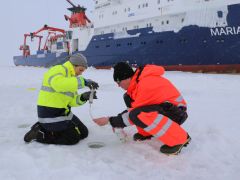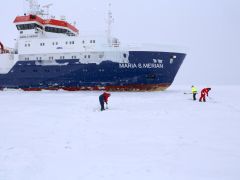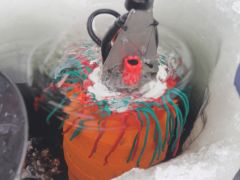
Home run for the RV Maria S. Merian:
Research vessel sets off towards the Baltic Sea ice
for the "Deep Baltic" mission
13.03.2021 – Sea ice impressions of a scientific assistant
The active support in the form of numerous ice-loving scientific assistants during the work on the sea ice floes fueled the good mood on all sides and contributed to an uplifted atmosphere. We all share a fascination for the ice and are highly motivated and committed to the task. Viewed from the peildeck, the ice landscape seems uniquely untouched and infinitely vast, and stepping onto the ice surface gives you the feeling of landing on the moon. Somehow surreal. The icy wind makes many a beard freeze and brings tears to one's eyes.
At the first ice station I take over the cranking of the microstructure probe down to a depth of 70 m and then up again - in 10 minute intervals. „Lowering with 30 centimeters per second!“ is the motto. As good as possible with a slight imbalance at the crank, not too fast and not too slow, always moving steadily. Then you can heave as fast as you like. A nice side effect is that the freezing cold can't do you any harm. Work is literally the warmest jacket!
If your toes do freeze, a round of ice hockey with a piece of discarded ice core as a puck will help. 
Special care is then required when assisting in ice core removal for analysis for microplastics. First, a site is selected that is somewhat away from the popular square meters- after all, we want to avoid capturing microplastics introduced by us if possible. Then the core is milled out of the ice as usual and we pull out an ordinary branch saw to bag the surface separately: The rest of the ice core is cut into manageable pieces with an ordinary axe and collected.
A few days later, we successfully grabbed another suitable ice floe. Armed with snow pushers and shovels, we set about freeing a 10 x 10 m field from about 20 cm of frozen snow - no easy task. After 5 minutes we are soaking wet with sweat. The effort is worth it, because on this day the best brine holes we ever had are created! Brine is the salty pore water from the sea ice. It seeps out oft he ice and accumulates in the iceholes after they are drilled. After tapping the area with 17 boreholes, the tasting begins: We taste the salinity of the brine that forms. The saltier the better! The favorites are sampled.
Text: Jasmin Ebert (CAU)
Photos: Barbara Hentzsch, Toralf Heene (both IOW) | click photos to enlarge
| Expedition: | MSM99 |
| Mission: | Deep Baltic |
| Start: | 25.02.2021 - Emden |
| Destination: | 23.03.2021 - Emden |
Maria S. Merian: current position


